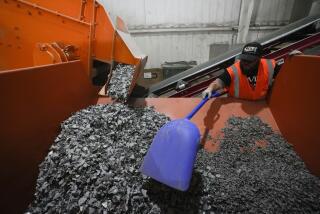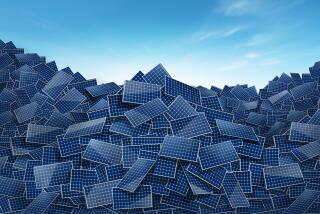New approach may power future of solar
- Share via
TAIPEI, TAIWAN — High energy prices are fueling a sleek new kind of solar technology that could someday set skyscrapers and high-rise apartment windows quietly buzzing with renewable power.
The emerging technology uses so-called thin films mounted on glass windows and other surfaces to harness the sun’s rays.
It’s more attractive and cheaper than the bulkier conventional solar cells made from polycrystalline silicon. Plus, the silicon supply has tightened and prices have risen as solar energy has taken off.
Current thin film surfaces generate less power in the same area than polysilicon modules, but they use much less polysilicon than conventional cells, making them attractive to some of the world’s top solar panel makers.
“Silicon is in short supply. This is a very critical issue, so at the moment we are focusing on thin film investment,” said Tatsuo Saga, deputy general manager of Japan’s Sharp Corp. solar systems, an industry leader.
Thin film is cheaper to produce, more durable and less unsightly than bulky solar panels, which are often called eyesores. The transparent sheets can serve as facades for skyscrapers and house roofs, where they turn sunshine into energy.
“One big advantage of the thin film products is that they don’t have to use too many raw materials and they are much cheaper than silicon solar wafers,” said Robin Cheng, an analyst at UBS Securities.
The potential has attracted major solar energy players such as Germany-based Q-Cells as well as industrial giants such as Applied Materials Inc., the world’s biggest maker of semiconductor manufacturing equipment. Both see big growth potential in selling thin film machinery.
Silicon accounts for 40% to 50% of the cost of conventional modules, which require 200 times more silicon than thin film.
The latter’s cost advantage combines with its ability to serve as attractive transparent panels on large buildings.
“We are sure in the years to come we’ll have the same-sized [products] as architectural glass,” said Winfried Hoffmann, chief technology officer of Santa Clara, Calif.-based Applied Materials’ solar business group.
Despite thin film’s promise, the technology still faces many challenges, said Jerry Yang, vice president of United Solar Ovonic Corp.
In terms of generating efficiency, or the percentage of power produced from captured sunlight, thin film modules average around 6%. That is less than half the 15% of traditional crystalline silicon cells, according to Solarbuzz, a research and consulting company.
“A lot of work needs to be done to expand the market, reduce costs and improve the efficiency,” Yang said. “Our product efficiency is 8%. Within a short time, we will reach 8.5% or even 9%. That’s our goal.”
The payoff is in the lower cost.
Thin film modules were being sold in Europe in November for $3.69 a watt, compared with $4.29 a watt for the lowest-priced traditional multicrystalline module of similar power in the United States, according to a Solarbuzz survey.
“The lower retail prices are making companies interested in the technology as an alternative. However, there is a large capital expenditure to build a thin-film plant and the solar power conversion rates are low,” wrote KGI Securities researchers in Taipei.
“It’s still too early to know if it can be a profitable technology in the future, as we’ll have to see if the conversion rate can be boosted and also how many players enter the market, which will affect competitiveness,” KGI said.
Many believe thin film’s efficiency will steadily rise with improving technology, possibly reaching 15%, which would enable it to take a bigger share of the solar energy market.
Thin film could account for up to 30% of the global solar cell market by 2010, from around 7% in 2006, Taiwan’s E-Ton Solar estimates.
Sharp Corp. plans to boost its thin film solar cell production capacity from 15 megawatts a year to 1,000 megawatts by 2010 with the construction of a massive plant in Sakai City, Japan.
More to Read
Inside the business of entertainment
The Wide Shot brings you news, analysis and insights on everything from streaming wars to production — and what it all means for the future.
You may occasionally receive promotional content from the Los Angeles Times.







